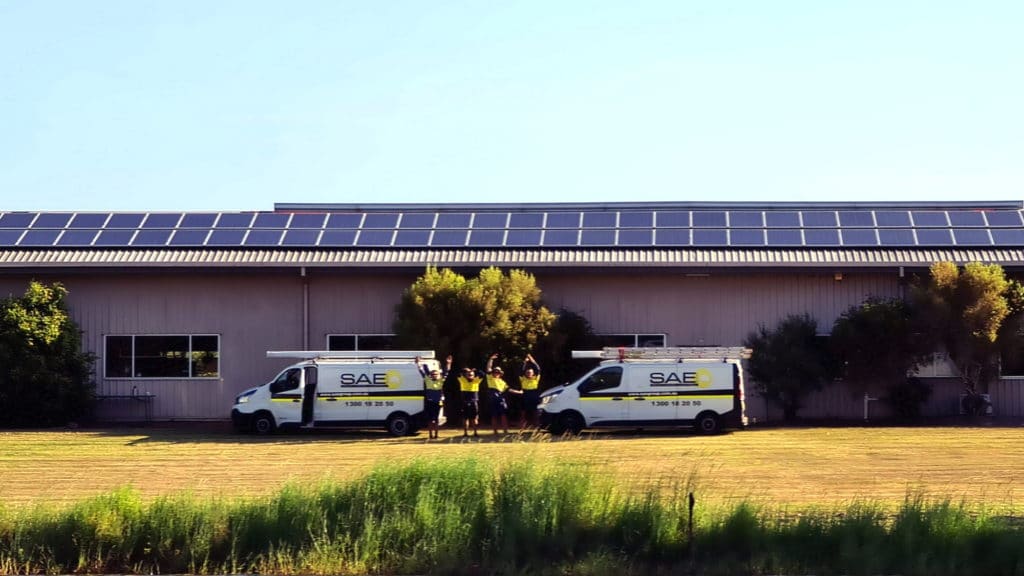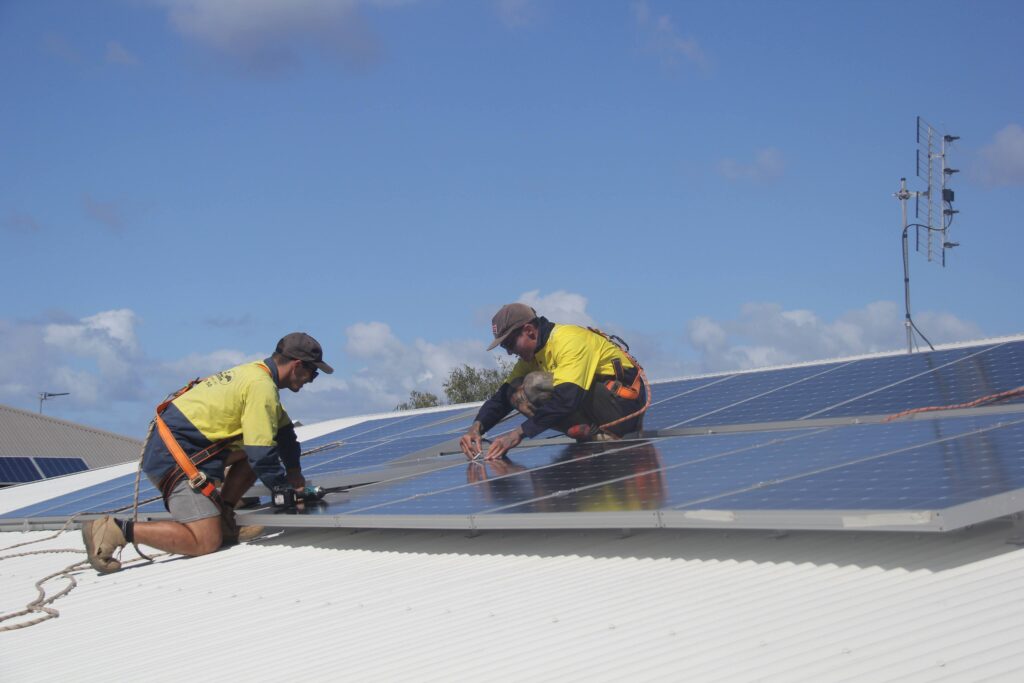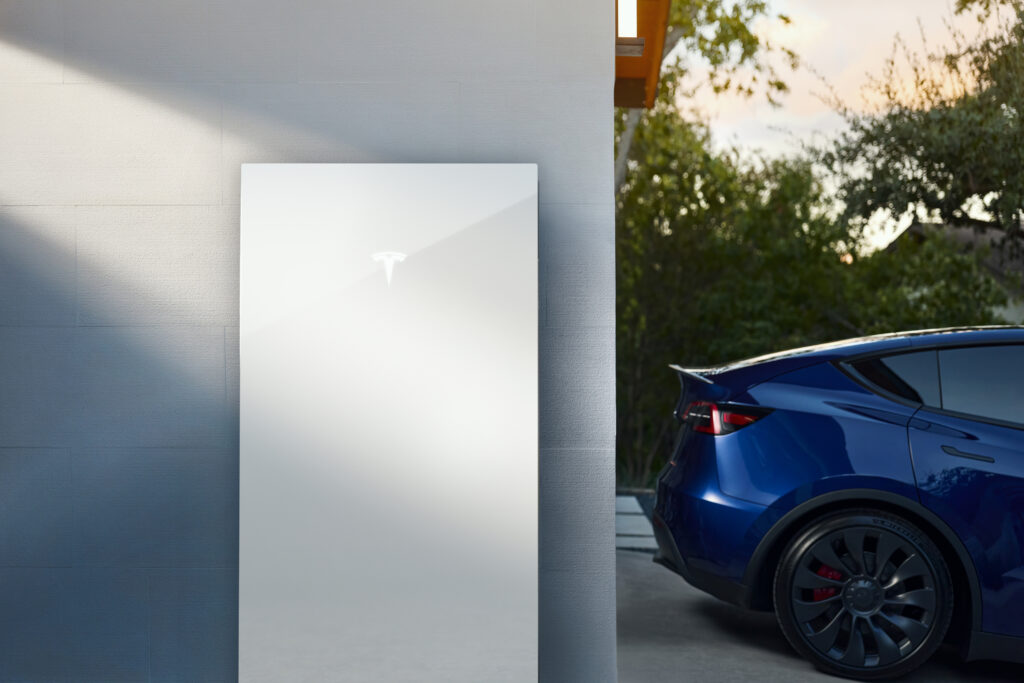Did you know heat pump hot water systems can slash energy use by 70% compared to standard electric systems? It sounds impossible, but these clever systems actually achieve efficiencies of 300% to 400% — operating above 100% efficiency.
But what exactly is a heat pump hot water system? Simply put, it’s a smart alternative to traditional water heaters that captures heat from the surrounding air and transfers it to your water. With hot water accounting for roughly 23% of the average Australian home’s energy consumption, this technology offers serious savings for cost-conscious homeowners.
These systems are rapidly gaining popularity across Australia, and for good reason. Last year alone, heat pump hot water installations jumped by an impressive 70%. When comparing heat pump systems to gas options, the numbers speak for themselves — heat pumps typically run 50-70% cheaper. For NSW households, this can translate to annual savings between $800 and $2,200 on energy bills after making the switch.
Why is the power consumption so low? Heat pump systems need 3 to 4 times less energy than traditional element-based tanks. Yet they still deliver water heated to 60°C, meeting the standard temperature requirements for hot water storage.
In this guide, we’ll break down everything you need to know about heat pump hot water systems. From the science behind how they work to the practical benefits, potential limitations, and available government incentives — we’ve got you covered.
What is a Heat Pump Hot Water System?
Heat pump hot water systems work on a completely different principle than your standard water heater. Rather than creating heat, these clever systems transfer existing heat from the surrounding air to your water. This simple difference is what makes them remarkably efficient.
Think of a heat pump water heater as a refrigerator working in reverse. While your fridge pulls heat from inside and dumps it outside, a heat pump captures heat from the air and transfers it to water. This process involves a refrigeration cycle where a special fluid (refrigerant) absorbs heat, gets compressed to boost its temperature, then passes that heat to water in a storage tank.
How It Differs From Traditional Systems
Standard electric water heaters use resistive elements (like an electric kettle) to heat water directly. Heat pumps, however, use electricity mainly to run a compressor and fan. This fundamental difference is why heat pumps use 60-75% less electricity than conventional systems.
The efficiency difference is measured by something called coefficient of performance (CoP). Traditional electric systems have a CoP of 1 (100% efficiency), but heat pumps typically achieve CoPs of 3-4 (300-400% efficiency). In simple terms, they produce 3-4 units of heat energy for every unit of electricity they consume.
Another key advantage is when these systems operate. Unlike traditional systems that often need off-peak electricity rates, heat pumps run effectively during daylight hours. This makes them perfect for homes with solar panels, potentially using excess solar power to heat your water.
Heat pump systems come in two main types:
- Integrated systems: The compressor and water tank form a single unit, with the compressor typically sitting on top of the tank.
- Split systems: The compressor is separate from the water tank and can be mounted on a wall or ground nearby, offering more flexibility for installation.
Both types need proper ventilation as they rely on ambient air to function effectively.
Heat Pump Hot Water vs Gas Systems
When comparing heat pumps to gas systems, several important differences stand out. Gas systems heat water directly through the combustion of either natural gas or LPG. As a result, they typically produce more greenhouse gases over their lifetime.
To put this in perspective, a standard 5-star energy-rated gas storage system will generate about 8.5 tons of greenhouse gases over 10 years. A high-efficiency heat pump, by comparison, produces only around 4.1 tons during the same period. That’s a significant reduction that makes heat pumps better for the environment.
Beyond operational emissions, gas systems rely on non-renewable resources that cause environmental damage during extraction and processing. Heat pumps use electricity that can increasingly come from renewable sources, including your own solar panels.
While heat pumps excel in efficiency and environmental performance, they do have some limitations. They work best in warmer temperatures, though modern systems can still function effectively in sub-zero conditions with a CoP of at least 2. Unlike gas systems, heat pumps also produce some noise during operation, similar to an air conditioner, which should be considered when deciding where to install them.
That said, heat pumps can extract heat even from cold air (air at 0°C still contains over 90% of the heat energy of air at 40°C), making them versatile across Australia’s varied climate zones.
How Does a Heat Pump Hot Water System Work?
Heat pump hot water systems rely on the clever principle of heat transfer rather than heat generation. Just like a refrigerator running in reverse, these systems pull heat from one place and move it to another—specifically, from the air around us to your water supply.
Step-by-Step Working Process
The operation follows a 5-step refrigeration cycle:
- Air intake: A fan draws surrounding air into the system’s evaporator.
- Heat absorption: As this air passes over an evaporator coil containing refrigerant, the refrigerant absorbs heat from the air and changes from liquid to gas.
- Compression: The refrigerant gas moves to a compressor where it’s squeezed, dramatically increasing its temperature and pressure.
- Heat transfer: The hot refrigerant gas flows through a heat exchanger (condenser) that’s in contact with water, transferring its heat to the water in your storage tank.
- Cycle completion: After giving up its heat, the refrigerant cools, returns to liquid form, and flows back to the evaporator to start the cycle again.
This process is incredibly efficient, with modern heat pump systems achieving a Coefficient of Performance (COP) between 3.6 and 5.2. Simply put, they produce 3.6 to 5.2 times more heat energy than the electrical energy they consume.
Air-Source vs Ground-Source Systems
Most heat pump hot water systems in Australia are air-source heat pumps, which extract heat from the air around us. These systems work well across a wide temperature range—even in temperatures as low as 4.4°C (40°F).
Ground-source heat pumps (also called geothermal systems) extract heat from the earth through underground pipes. These systems tap into the constant subsurface ground temperature (4.5°-21°C or 40°-70°F).
Key differences between these systems include:
- Efficiency: Ground-source systems typically offer higher efficiency as underground temperatures stay relatively constant year-round, unlike air temperatures that fluctuate.
- Installation complexity: Air-source systems are much simpler to install, while ground-source systems require excavation for underground piping.
- Lifespan: Ground-source systems often last longer, with underground components potentially lasting 50+ years compared to 24 years for internal components.
- Applications: Some ground-source systems can provide heating, cooling, and hot water simultaneously through “triple-function” setups.
Integrated vs Split Systems
Heat pump hot water systems come in two main configurations:
Integrated systems combine the heat pump unit and water storage tank into a single appliance, with the compressor typically sitting on top of the water tank. These systems:
- Need a less complex installation
- Require more clearance from walls for proper air circulation
- Are heavier as a single unit
- It may be harder to place due to noise considerations
Split systems separate the heat pump unit (containing the evaporator, fan, and compressor) from the water storage tank. With these systems:
- The noisy components can be placed outdoors
- The tank can be positioned indoors or elsewhere
- Installation is more complex, requiring refrigerant piping between components
- You have more flexibility in where components are placed
Both configurations need good ventilation to access ambient air for efficient operation. Split systems typically offer greater installation flexibility, allowing you to position the potentially noisy compressor away from bedrooms or living areas.
Higher-efficiency systems often use variable speed compressors (inverters) that adjust their speed based on demand, improving energy efficiency and extending system lifespan.
Understanding Costs and Installation
Making the switch to a heat pump hot water system involves more than just the initial purchase price. Understanding the full picture of costs and installation requirements helps you make a smart decision about this energy-efficient technology.
Heat Pump Hot Water System Price Range
The market offers heat pump systems across different quality tiers. Entry-level systems provide basic functionality, mid-tier options balance cost with performance, and premium models, while requiring a higher upfront investment, often deliver superior efficiency and longer warranties.
When weighing the value of these systems, remember that conventional water heaters have lower upfront costs, but heat pumps offer significantly reduced running costs that offset the initial investment. In fact, a quality heat pump system can become cost-neutral within 4-6 years compared to standard systems.
Installation Requirements and Challenges
Professional installation by qualified technicians is absolutely essential for heat pump hot water systems. Installation should be handled by licensed plumbers with appropriate water supply accreditation. If you’re replacing a gas water heater, the work requires a gasfitting qualification as well.
Key installation requirements include:
- Proper ventilation: Systems must be installed in well-ventilated areas, typically outdoors, with good airflow
- Noise consideration: Units should be positioned away from bedrooms and neighbours to minimise noise disturbance
- Clearance requirements: Typicall,y 25cm clearance around the unit is needed for proper operation
- Base support: A stable, level foundation (often a concrete pad) is necessary
Unique challenges might include access to the installation site, potential electrical upgrades, and proper handling of refrigerant connections for split systems.
Factors that Affect Total Cost
Several variables impact the overall expense of heat pump hot water systems. System type is a major factor, with integrated units generally requiring simpler installation while split systems offer greater placement flexibility.
Installation complexity definitely affects overall costs, especially when existing plumbing or electrical configurations need modification. Site access challenges or specialised lifting equipment requirements can increase installation expenses.
Climate considerations play a role too, as systems installed in colder regions may need additional features to maintain efficiency. Brand reputation and warranty length are important value considerations, with warranty periods typically ranging from 5-10 years for tanks and 2-8 years for heat pump components.
Fortunately, homeowners can offset costs through various government incentives and rebates, making these systems increasingly accessible despite their higher initial investment.
Government Rebates and Incentives
Government programs across Australia offer substantial support for homeowners switching to heat pump hot water systems, making them more affordable and accessible than ever before.
Federal STC Rebate Explained
The Small-scale Technology Certificates (STCs) program is a nationwide incentive for the installation of heat pump hot water systems. This federal scheme recognises these systems as renewable energy technology, allowing homeowners to create certificates based on the estimated electricity their system will save over its lifetime.
STCs work essentially as a point-of-sale discount, reducing the upfront purchase cost. The number of certificates a system generates depends on its installation location, capacity, and efficiency. Australia is divided into climate zones that determine STC values, with colder regions typically receiving higher rebate amounts.
Homeowners can either trade these certificates themselves or, as happens in most cases, assign the right to create STCs to their installer in exchange for an immediate discount on their purchase.
State-Based Programs (NSW, VIC, etc.)
Beyond the federal scheme, several states offer additional incentives:
- Victoria runs two significant programs: Victorian Energy Efficiency Certificates (VEECs) and the Solar Victoria rebate. VEECs provide additional discounts for replacing inefficient electric or gas systems, while the Solar Victoria program offers rebates for eligible heat pump installations.
- New South Wales implements the Energy Savings Scheme, creating Energy Savings Certificates (ESCs) when replacing existing electric or gas water heaters with approved heat pump systems.
- South Australia offers rebates through the Retailer Energy Productivity Scheme (REPS), with additional incentives available for Adelaide city residents.
Eligibility and How to Apply
Eligibility criteria typically include:
- System requirements – the heat pump must be on the Clean Energy Regulator’s approved products register
- Installation requirements – work must be completed by appropriately licensed tradespeople
- Property conditions – some programs have property value limits or require owner-occupier status
- Existing system requirements – many rebates apply only when replacing systems of a certain age
The application process usually starts with selecting an authorised retailer or installer who will handle the paperwork. For most programs, the installer initiates the application, obtains necessary documentation from you, and applies the discount directly to your final invoice.
First-time applicants should research available programs in their location, as rebates can often be combined for maximum benefit.
Pros and Cons of Heat Pump Hot Water
Heat pump hot water systems offer significant advantages alongside some limitations that homeowners should weigh before making their decision.
Energy Efficiency and Power Consumption
Heat pump technology stands out primarily for its exceptional efficiency. These systems typically use 60-75% less electricity than conventional electric hot water systems. This dramatic reduction happens because they move heat rather than generate it directly.
The efficiency is measured through the coefficient of performance (CoP). While traditional electric systems operate at a CoP of 1 (100% efficiency), heat pumps achieve CoPs between 3-4, meaning they deliver 300-400% efficiency. In practical terms, they generate 3-4 units of heat energy for every unit of electricity consumed.
For homes with rooftop solar panels, these systems can be programmed to run during daylight hours, effectively using excess solar power. This strategic timing further reduces grid electricity consumption.
Noise and Climate Limitations
One notable consideration is the operational noise produced by heat pumps. The fan and compressor generate sound levels typically between 40-60 decibels—comparable to a refrigerator’s hum or quiet background music. This noise level increases slightly during colder months when systems work harder to extract heat.
Regarding climate performance, heat pumps function most efficiently in moderate temperatures between 4.4°-32.2°C (40°-90°F). Even though efficiency decreases in colder conditions, modern systems can still operate effectively at temperatures as low as -7°C, albeit with lower CoP ratings.
Environmental Benefits and Drawbacks
Heat pump systems deliver substantial environmental advantages. By using less electricity, they produce fewer greenhouse gas emissions—potentially reducing your carbon footprint by up to 75% compared to conventional electric heaters.
This reduction is equivalent to not driving for 10 months or switching to a plant-based diet. When paired with renewable electricity sources, these systems become virtually emissions-free.
The main environmental limitation relates to installation requirements. Heat pumps need proper ventilation and at least 1,000 cubic feet of air space, which may restrict placement options in some homes.
Final Thoughts on Heat Pump Hot Water Systems
Heat pump hot water systems truly represent a leap forward in home energy efficiency, delivering 300–400% more efficiency than traditional systems by harnessing heat from the air. The advantages go far beyond cutting your power bills — switching can shrink your household carbon footprint by up to 75%, the equivalent of taking your car off the road for nearly a year! And if you have solar panels, you’re essentially heating your water with free sunshine.
Modern heat pump systems are designed to perform reliably even in colder climates, and while they produce a gentle hum (similar to a fridge), the energy savings and environmental benefits far outweigh this minor consideration. Plus, with generous government rebates and incentives available, the upfront investment is now more accessible than ever.
But here’s the key: to truly unlock the full potential of your system, expert installation is critical. That’s where SAE Group comes in. Our fully qualified, experienced technicians ensure your heat pump is installed to the highest standard — with the right ventilation, placement, and configuration — so you get maximum performance, savings, and peace of mind.
Ready to upgrade your hot water system and start saving? Contact SAE Group today for a free consultation and discover how we can help you make the switch to smarter, cleaner, more efficient hot water.
Ready to start saving costs on energy bills?
Share This Post With Others!
Related Post
Recent Posts
Archives








